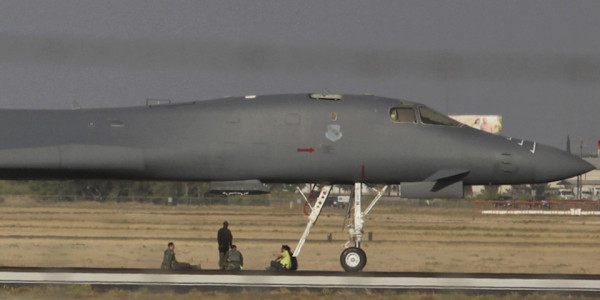

The emergency landing of a B-1B Lancer bomber at Midland International Air Space Port in Midland County, Texas on May 1st reportedly involved heroic action on the part of the crew to save both the aircraft and a potentially stranded crewmember following a serious ejector seat malfunction.
The incident sparked attention after photos captured by eyewitnesses and local media circulated showing melted engine nozzles and a blown escape hatch. In the weeks since the incident, the Air Force has been short with details, telling Task & Purpose only that the B-1B was able to land safely after the crew “experienced an in-flight emergency.”
“The port’s emergency responders responded to the aircraft upon landing,” the 7th Bomb Wing Headquarters told Task & Purpose in a statement without further elaboration on how the four-man Lancer aircrew responded to the in-flight incident. “There were no munitions on the aircraft.”
But on May 21, the well-sourced Air Force amn/nco/snco Facebook page posted several new details passed along by airmen ostensibly stationed at Dyess that potentially shed new light on what exactly happened aboard the crippled airframe:
Yes, we know it’s the word of a single Facebook group over the word of the Air Force, but here’s what information Air Force amn/nco/snco has managed to surface from chow halls across the country:
- The initial problem: The “in-flight emergency” mentioned by the Pentagon was reportedly an engine fire, according to unidentified Air Force personnel who shared accounts with Air Force amn/nco/snco; while the extinguisher systems were activated to put out the blaze, the fire indicator light did not go off after their use, which may have indicated a failure to extinguish the fire. If this reading is accurate, the extinguisher failure could have led to an uncontrolled and catastrophic fire that could have potentially resulted in the complete loss of the aircraft in a rapid period of time.
- The ejection: While the Air Force did not immediately comment to on the ejector seat malfunction, the B-1B’s offensive system operator reportedly attempted to eject from the aircraft until he discovered his ACES II ejection system had malfunctioned, preventing his escape. The mission commander elected to attempt to land the aircraft instead of abandoning it with the stranded crewmember still on-board.
- The landing: The B-1B made its emergency landing at Midland International Air and Space Port with minimal incident. The image posted to the Air Force amn/nco/snco page shows extensive fire damage to the right side engines, as well as the open ejection port. Luckily, no one in the crew or on the ground was reported injured, according to the Air Force.
- The airframe: The B-1 airframe experienced multiple ejection seat issues early in its service life. During the B-1’s development in 1984, the prototype suffered a crash which resulted in the death of the test pilot, Doug Benefield, and serious injuries to two other crew members after the ejection capsule failed; another ejection failure caused the death of a crewmember in September 1987. B-1B’s ejection system has performed without major issue in the 30 years since until this incident.
While the Air Force said in its press release that incident was still under investigation, and also noted that the safety investigation board findings are “are protected by the military safety privilege and are not subject to release.” Unfortunately, this means it may be some time before the details discussed in Air Force amn/nco/snco are officially corroborated.

U.S. Air Force Lt. Col. Brian Crawford, 7th Mission Support Group deputy commander, briefs members from Secretary of the Air Force installations, environment and energy visited Dyess to learn about the base’s mission and the B-1B Lancer’s capabilities, Nov. 2, 2016, at Dyess Air Force Base, Texas.U.S. Air Force/Airman 1st Class Austin Mayfield
But if the information shared with Air Force amn/nco/snco is indeed accurate, the mission commander on this ill-fated B-1B sortie likely faced the mortifying choice of saving the remaining two crewmembers and their own life by ejecting or risking all of their lives to land the crippled aircraft. Had the fire spread it could easily have resulted in a flashpoint situation which would have destroyed the entire aircraft in short order.
By landing the crippled B-1B intact the anonymous instructor pilot and co-pilot saved a $300 million dollar national asset and, more importantly, the lives of their fellow crew members. That is, quite literally, courage under fire.

A enlisted thinktank brought to you by Task & Purpose
WATCH NEXT:
